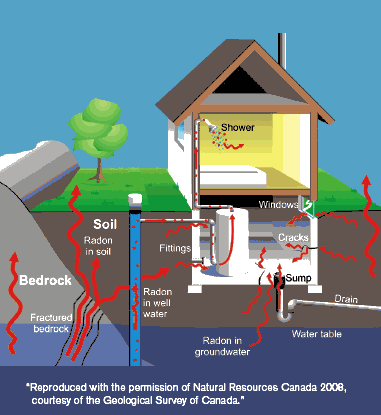How Radon Enters a House
The air pressure inside your home is usually lower than the soil surrounding the foundation. This difference in pressure draws air and other gases, including radon, from the soil into your home. Radon can enter a home any place it finds an opening where the house contacts the soil: cracks in foundations walls and in floor slabs, construction joints, gaps around service pipes, support posts, window casements, floor drains, sumps or cavities inside walls.

Radon is a naturally occurring radioactive gas that is formed by the breakdown of uranium in soil, rock and water. It cannot be detected by the senses, meaning you cannot see it, smell it or taste it; however, it can be detected easily with radon measurement devices. When radon escapes from the ground to the outdoors, it mixes with fresh air resulting in concentrations too low to be of concern. When radon enters an enclosed space such as a home it can accumulate to high concentrations and become a health concern. The only known health risk associated with long term exposure to radon is an increased risk of developing lung cancer. The level of risk depends on the concentration of radon and duration of exposure.
While some amount of radon is expected to be found in any home across Canada, the only way to know how much radon is in a home is to test. The source of most radon in houses is the soil on which the house is standing and for that reason higher indoor radon levels are more likely to exist in the lower levels of the house.
What are the Health Risks?
-
Radon exposure is the leading cause of lung cancer in non-smokers and the second leading cause of lung cancer in smokers.
-
Radon-induced lung cancer causes 3,000+ deaths each year in Canada.
-
People who smoke and are exposed to radon have an even higher risk of lung cancer.
-
The health risk from radon is long-term not immediate. The longer you are exposed to high levels of radon, the greater your risk.

